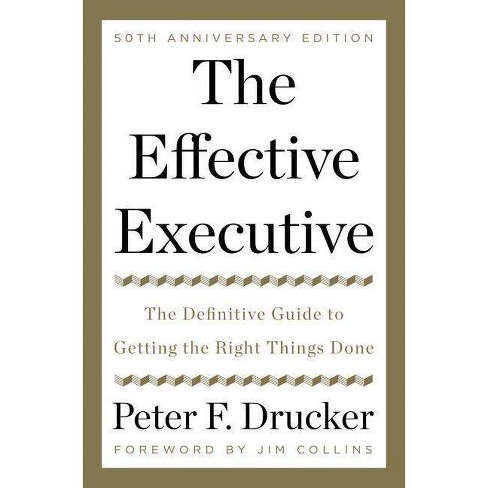Drucker, Peter F. The Effective Executive. New York: Harper and Row: 1966.
I’m an executive. Don’t laugh. You probably are too. It’s not your job title that makes you an executive, argues Peter Drucker. You’re an executive if you’re responsible for contributing to your organization’s performance and helping it produce results.
“Knowledge worker” is Drucker’s other synonym for this executive, the person who deals in ideas rather than widgets. While a manual worker can focus on efficiency—doing a task in less time—effectiveness is the true measure of an executive. Take student assessment, for example. Efficiency would measure how fast I grade papers. Effectiveness would measure what to assess in each paper and (more importantly) why the assessments were worthwhile in the first place. Drucker’s book has been the guide for helping executives put “first things first,” twenty years before Steven Covey made that phrase one of his 7 Habits of Highly Effective People. The Effective Executive starts with the premise that someone can learn to be effective and then distills the habits of that effectiveness into five skills.
First, effective executives record and analyze their use of time. Drucker estimates that only 25% of executives’ time is left to their discretion. The rest is spoken for. The only way to use that time well is to see where it goes and figure out where it might be better spent. Again, efficiency is not necessarily the goal. You may not need to do something faster. You may not need to do it at all. Knowing how you use your time also means knowing what needs the most time, for instance, personnel matters. Better to measure twice and cut once when making a hire than have to repeat the process after a quick “efficient” decision.
Second, effective executives focus on contribution. Activity matters less than productivity. An executive can contribute in three ways: to an organization’s direct results, the formation and reaffirmation of the organization’s values, or building and developing people. If you don’t know your organization’s direct results or values, you can’t contribute to or affirm them; it’s hard to know how to develop people if you don’t know what you’re developing them for.
Third, effective executives turn strengths into productivity. Just as focusing on contribution helps define how you use your time, so does turning strengths into productivity define how to develop people, including yourself. You have to know what you do well. You then must figure out how to turn that skill into a contribution. Researching and writing well are strengths. Researching annual reports and writing best practices manuals are contributions. Drucker singles out General George Marshall and GM CEO Alfred P. Sloan as exemplars of this principle.
Fourth, effective executives concentrate and work on what matters most. Fifty years before Cal Newport published Deep Work, Drucker knew that concentration was the secret to effectiveness. While the first principle demands that you observe what happens to you in the course of a day, this principle demands that you concentrate on the most important thing you can make happen. Not all contributions are equal. Neither are all strengths. The best executives determine where and how they can make their most productive contributions and devote themselves accordingly.
Fifth, effective executives make actionable decisions. This begins with correctly classifying the decision. Is the dilemma generic or unique? If the former, the decision requires a rule or principle that can make similar decisions easier, thus avoiding situation-by-situation pragmatism. If the latter, then rote responses will not work. Drucker argues that the Kennedy Administration was ineffective largely because of its inability to develop and apply general principles. Its one success? Handling the unique situation of the Cuban Missile Crisis. After determining the dilemma’s type, executives must set decision boundaries. Here, the key question is: what is the minimum required to solve the problem? Next, executives must make decisions based on what is right rather than compromise for what is acceptable. Very rarely do we know what compromises are the right ones. Beginning with compromise leads nowhere. Finally, the decision should have its action steps built into it. What must be done? Who is responsible for doing it? You haven’t made a decision if you can’t answer those questions.
After a single reading, the book makes more rational than emotional sense. By that, I mean that the strategies Drucker recommends logically click for me but that the emotional provocation for implementing them is something I will have to get from elsewhere. I read the book because, like many knowledge workers, I struggle with differentiating efficiency and effectiveness. The book’s single most compelling point is about contribution. If I start assessing how I use my time by asking, “How am I helping?” I will be more likely to work on things that matter. Most likely, I will reread the book in six months and see if it strikes me any differently. This is the kind of book that bears revisiting. Until then, I’ll see what kind of contribution I can make.

